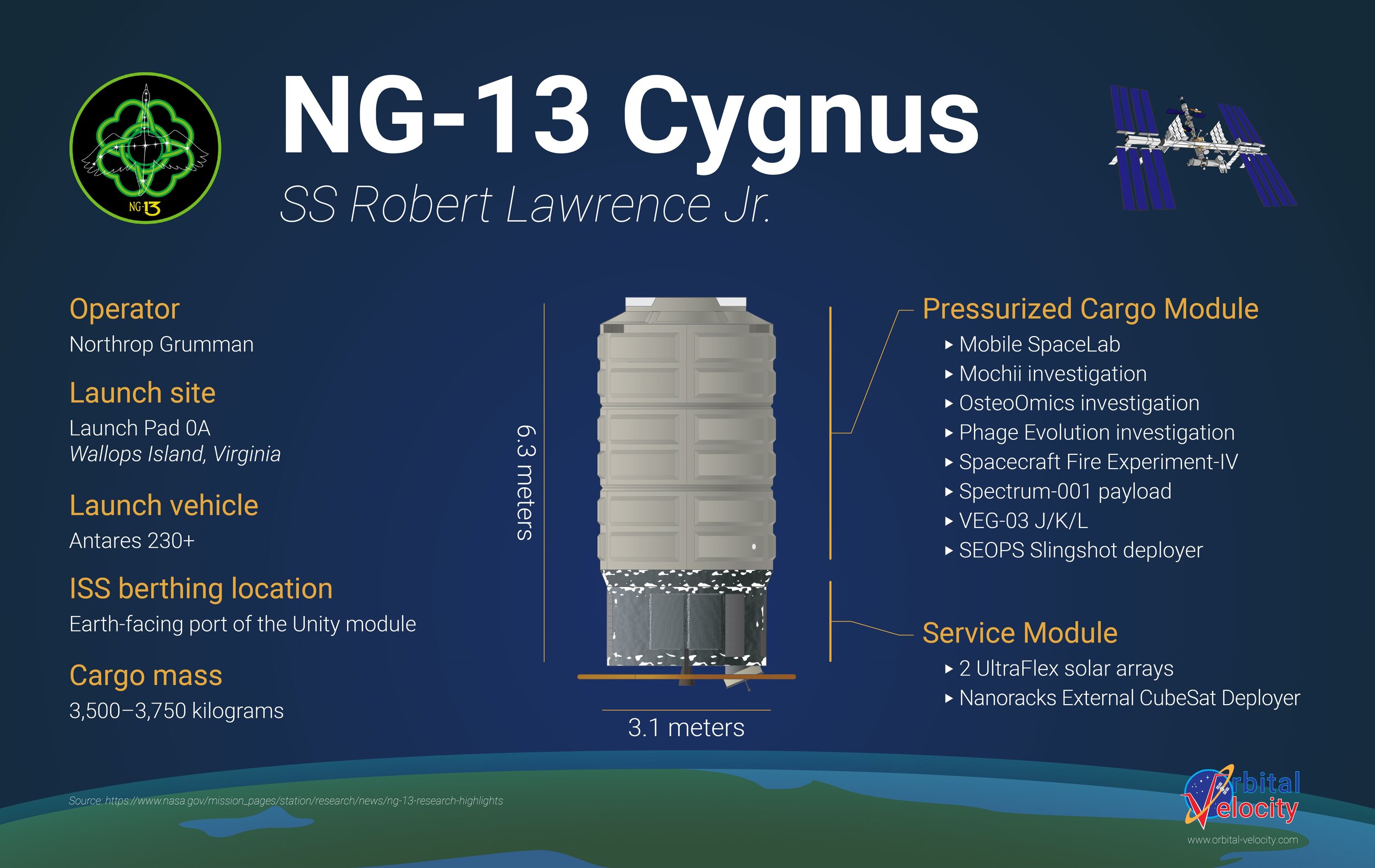NG-13 Cygnus berthed to the International Space Station
/With some 3,700 kilograms of crew supplies and science experiments, the unpiloted NG-13 Cygnus spacecraft arrived at the International Space Station and was berthed to the Earth-facing port of the Unity module.
Capture by the 17.6-meter-long Canadarm2 remote manipulator system took place at about 9:05 UTC Feb. 18, 2020. Ground-based teams then commanded the robotic device to move the spacecraft to its berthing location, securing it firmly to the outpost at 11:16 UTC.
“The Cygnus NG-13 vehicle ... is named in honor of U.S. Air Force Maj. Robert H. Lawrence Jr.,” said NASA astronaut and Expedition 62 Flight Engineer Drew Morgan moments after the spacecraft was captured by the robotic arm. “As the first African American to be selected as an astronaut by a national space program, Robert defined possible against the odds when he was selected for the U.S. Air Force’s Manned Orbital Laboratory project in 1967.”
Morgan went on to say Lawrence was killed in an aircraft accident later that same year.
“But while Robert never launched into Earth orbit, he remains a valuable symbol of progress and inclusion in human spaceflight, and it’s our honor to welcome the SS Robert H. Lawrence Jr. aboard the ISS,” Morgan said.
NG-13 Cygnus was launched into space atop an Antares rocket at 20:21 UTC Feb. 15, 2020, from Pad 0A at the Mid-Atlantic Regional Spaceport on Wallops Island, Virginia. Nine minutes later, the vehicle was deployed into space and to begin its chase of the ISS.
As of this writing, there are two Cygnus spacecraft in orbit. NG-13, which is of course at the space station, and NG-12, which recently departed the outpost and is on a multi-week post-ISS mission, which involves the deployment of several CubSats.
Northrop Grumman demonstrated its ability to support more than one Cygnus spacecraft in orbit late in 2019.
Moreover, with the NG-13 flight, the company showcased its mission flexibility by launching roughly 3.5 months after the previous mission — earlier than initially planned. These flights have traditionally launched roughly six months apart.
According to Northrop Grumman officials, the company may do that again with the NG-14 mission, should NASA request it. Right now, that mission is slated for October 2020. However, it could be moved up to August.
There are several science experiments and hardware aboard the NG-13 Cygnus spacecraft. NASA has highlighted five: a tissue and cell culturing facility called Mobile SpaceLab, a new miniature scanning electron microscope called Mochii, the OsteoOmics bone loss investigation, the Phage Evolution investigation and the fourth Spacecraft Fire Experiment experiment — Saffire-IV.
According to NASA, the Mobile SpaceLab facility is designed to be a quick-turnaround platform to perform biology experiments relating to human physiology to determine ways to mitigate the negative effects of microgravity on the human body. The U.S. space agency said the facility can be reconfigured for the needs of specific investigations.
Mochii is the first portable scanning electron microscope with spectroscopy. It is about half the size of a bread maker and can fit in a suitcase or in an overhead bin on an airplane, according to the company that created the instrument — Voxa.
According to NASA, Mochii is able to provide real-time, on-site imaging and measurements of micro- and nanostructures aboard the ISS. Additionally, the instrument comes with a wireless tablet interface in order to allow for “all levels of operators” to utilize the experiment.
According to Voxa, anyone from a child scientist to a seasoned microscopist can “achieve impactful results at the nanoscale.”
Once unpacked from Cygnus, Mochii is expected to be stored in the Japanese Kibo module.
One experiment that was brought to the ISS was OsteoOmics, which aims to investigate the molecular mechanisms that cause bone loss, NASA said. In particular, the experiment looks to better understand osteoblasts, which are the cells that form bone, and osteoclasts, which dissolve bone.
Bone loss is one of the most well-known effects of microgravity on astronauts and cosmonauts. There are ways to mitigate some of these effects, such as rigorous daily exercise, but long-duration space travelers still experience a measurable loss in bone density upon return.
Another experiment aboard Cygnus is the Phage Evolution investigation. NASA said it is set to examine the effects of microgravity and radiation exposure on phages — viruses that infect bacteria — and their bacterial host interactions.
NASA said a better understanding of the effects of microgravity and cosmic radiation on bacteriophages could help with the development of phage technology in order to help protect the health of astronauts on future missions, including those into deep space.
Finally, probably the most high-profile experiment aboard Cygnus is the Saffire-IV investigation. Its goal, and the goal of the previous versions of this experiment over the last several years, is to better understand how fire develops and grows on certain large materials in various environmental conditions in space.
Traditionally, fire experiments are small in scale. One major reason for this is the safety of the astronaut and cosmonaut crews.
However, the Saffire experiments are only activated and performed after Cygnus has safely left the ISS, ensuring there is no danger to the outpost. Because of this remoteness, materials can be as large as poster board.
NG-13 Cygnus is slated to remain at the ISS until May 2020. During that time, its cargo will be unloaded and dispersed throughout the outpost. Meanwhile, trash and unneeded equipment will be loaded inside Cygnus to be disposed of at the end of the spacecraft’s mission.
After NG-13 Cygnus leaves the outpost, it will perform a multi-week post-ISS mission, deploying CubeSats and performing the Saffire-IV experiment.
Once all of that is concluded and the Saffire-IV data downlinked to Earth, Cygnus will be commanded to perform a deorbit burn to re-enter Earth’s atmosphere over the South Pacific Ocean.








